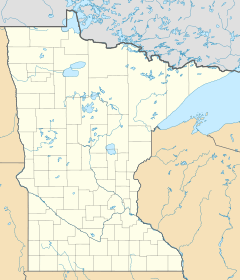Crooked Creek (Houston County, Minnesota) facts for kids
Quick facts for kids Crooked Creek |
|
|---|---|
|
Mouth of the Crooked Creek
|
|
| Country | United States |
| State | Minnesota |
| County | Houston |
| Physical characteristics | |
| Main source | 43°36′30″N 91°23′58″W / 43.6083034°N 91.3995823°W |
| River mouth | 43°34′24″N 91°16′06″W / 43.5733048°N 91.2684671°W |
| Basin features | |
| River system | Upper Mississippi River |
| Tributaries |
|
Crooked Creek is a small stream located in Houston County, which is in the state of Minnesota in the United States. It's called "Crooked Creek" because it doesn't flow in a straight line; it has many twists and turns!
Contents
What is the Driftless Area?
Crooked Creek is part of a special place called the Driftless Area. This area is unique because it was never flattened by glaciers during the last Ice Age. Because of this, it has steep hills, deep valleys, and many clear, cold streams like Crooked Creek.
Who Lives in Crooked Creek?
This creek is home to many different kinds of fish and other water creatures. The Minnesota Department of Natural Resources has studied the creek to see what lives there.
Some of the fish you might find include:
- Trout: Brown trout, brook trout, and rainbow trout are popular here. They love the cold, clear water.
- Other Fish: You can also find fish like golden redhorse, white sucker, common carp, and northern pike.
- Smaller Fish: There are also smaller fish like creek chub, longnose dace, and central stoneroller.
The first time scientists officially checked the fish in Crooked Creek was way back in 1921.
Where Does Crooked Creek Go?
The creek's mouth, which is where it flows into a larger body of water, is about one mile north of a town called Reno, Minnesota. Crooked Creek is part of the larger Upper Mississippi River system.
How is Crooked Creek Kept Healthy?
People have worked to make Crooked Creek an even better home for fish and wildlife. These efforts are called "habitat improvement." They happened in:
- 1974
- 1978
- 1984
These improvements help keep the water clean and create good places for fish to live, hide, and lay their eggs.
Images for kids



